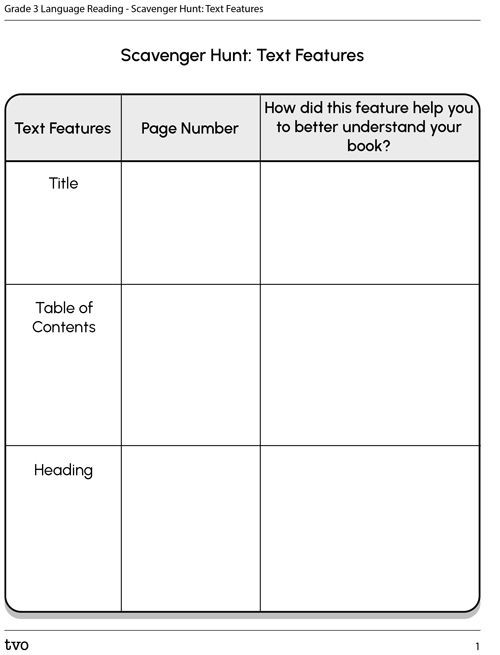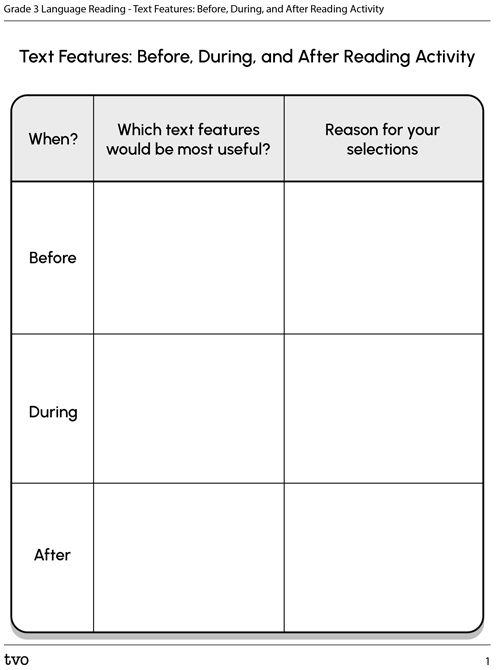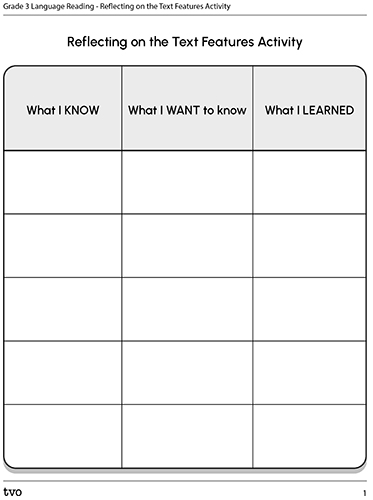Minds On
What helps us to understand text?

Brainstorm
What do you notice?
Have you ever followed a recipe from a cookbook or directions from a manual to build a structure? Perhaps you’ve explored a magazine on a topic that interests you.
What helped you to better understand the text?
Action
What are nonfiction texts?
Recipes, instructions, and magazines are all examples of nonfiction texts. Nonfiction texts are books that are based on fact. Can you think of other forms of nonfiction text?
Student Success
Think-Pair-Share
Nonfiction texts have a number of different text features that help the learner better understand the contents.
Consider the nonfiction text features that help you understand a text. If possible, share your ideas with a partner.
Note to teachers: See your teacher guide for collaboration tools, ideas and suggestions.
Examine the following image that outlines a variety of possible text features and how they help the reader navigate the text.

Task 1: Scavenger hunt
Select a nonfiction book of your choice.
Explore your book for three or four text features outlined in the template provided.
Complete the Scavenger Hunt: Text Features Activity in your notebook or use the following fillable and printable documents.

Press the Activity button to access the Scavenger Hunt: Text Features Activity.
Activity (Open PDF in a new tab)Text features and reading
Text features in nonfiction text help us before, during, and after the reading process.
Before
We can use text features to help us predict or anticipate what will be in the text. Think of text features that would be most useful before reading.
During
As we explore a text, text features can help us to ask questions, confirm or reject our predictions, connect information, and learn new vocabulary.
Which text features would be most useful at this stage of the reading process?

After
Text features can help us summarize what we learned. Think of the text features that you would use to help you after exploring a book.
Complete the Text Features: Before, During, and After Reading Activity in your notebook or use the following fillable and printable document.

Press the Activity button to access the Text Features: Before, During, and After Reading Activity.
Activity (Open PDF in a new tab)Consolidation
Using text features to support your learning
Read Winter Wake-Up, or a nonfiction book of your choice. Think about what you already know about the topic, what you would like to know about the topic, and what you learned from your text. Reflect on how the text features helped you to better understand the content.

The following component is not optimized for a non-visual experience. A transcript is available.
Complete the Reflecting on the Text Features Activity in your notebook or use the following fillable and printable document.

Press the Activity button to access the Reflecting on the Text Features Activity.
Activity (Open PDF in a new tab)Reflection
How do you feel about what you have learned in this activity? Which of the next four sentences best matches how you are feeling about your learning? Press the button that is beside this sentence.
I feel...
Now, record your ideas about your feelings using a voice recorder, speech-to-text, or writing tool.